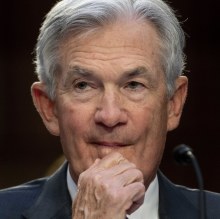US recession warning sets the stage for rate cuts

Bond investors are underestimating the magnitude of US interest rate cuts next year because the world’s largest economy is headed into a hard recession, setting the stage for lower interest rates in Australia.
That’s the view of an economist at Australia’s largest bank, even after data on Wednesday showed the US expanded at an upwardly revised annualised pace of 5.2 per cent in the third quarter, the fastest rate in almost two years. Forecasts were for a gain of 5 per cent.

US Federal Reserve chairman Jerome Powell. AP
“We consider the market is underpricing the upcoming rate-cutting cycle,” said Joseph Capurso, the head of international economics at Commonwealth Bank, in an interview. “The US economy will enter a recession that will force the Federal Reserve to cut the funds rate more aggressively to support the economy.”
Softening economic data, including a reading on inflation two weeks ago, has heightened speculation that the Fed is done with raising rates and that the economy is headed towards a soft landing that would allow it to start easing in the coming months. The US 10-year yield dropped to 4.3 per cent, from a top of 5 per cent in October, and was on course for the largest monthly decline since 2008.
The Fed has kept its policy rate in the 5.25 per cent to 5.50 per cent range since July, and markets imply scant chance of a move at the December 12-13 meeting.
Following the US GDP data, bond markets raised bets of rate cuts and are pricing in more than four cuts of a quarter percentage point each next year, starting in May. Earlier this week, the market was fully priced for a cut in June.
Some others tip an even earlier start. Billionaire hedge fund manager Bill Ackman said on Wednesday that Pershing Capital was “betting that the Federal Reserve was going to have to cut rates more quickly than people expect”.
The Taylor rules
Should the Fed keep rates in the roughly 5.5 per cent range when inflation trends below 3 per cent, that would be a “very high real rate of interest”, he said.
CBA has pencilled in 250 basis points of cuts over 2024 and 2025 in the US, noting that a typical Fed rate-cutting cycle in a low inflation period was about 300 basis points.
National Australia Bank, however, disputes the view, based on several so-called Taylor rules, a rough-and-ready guide to help central bankers meet their inflation targets.
“Our conclusion is that recent inflation would be consistent with a Fed Funds rate 75 basis points to 125 basis points lower than current levels,” said Tapas Strickland, NAB’s head of market economics. He said the current level of cuts implied by markets was about right.
“The Taylor rules analysis gives us greater confidence of our forecasts for 100 basis points of cuts in H2 2024,” he said.
The Taylor rules imply that an increase in inflation by one percentage point should prompt the central bank to raise the nominal interest rate by more than one percentage point.
More sizeable cuts, Mr Strickland said, would require a “sharper-than-expected apparent easing in the labour market and/or inflation heading below the Fed’s 2 per cent target”.
ANZ agreed with NAB’s estimates, predicting a rate reduction of 1 percentage point in the second half of ne.
“We forecast the target Fed funds rate range will be cut by 50 basis points per quarter until it reaches 3.25 per cent to 3.5 per cent in Q2 2025,” said Tom Kenny, a senior economist at ANZ, noting that would be 200 basis points below the current target range.
The sharp US Treasury rally was also felt in Australia, with traders dialling back bets of a cash rate increase and sharpening speculation of an earlier RBA cut. They imply a 28 per cent probability of an increase to 4.6 per cent by March, from 4.35 per cent currently. It was a 65 per cent probability earlier in the week. At the same time, they ascribe a small chance of an easing starting in August. On Monday, they had priced out any chance of a rate cut next year.

Analysts noted that although the Fed’s coming easing cycle had no direct implication on the RBA yet, the US policy action would help set the conditions for the Australian central bank to follow.
“Fed easing would therefore increase the likelihood of the RBA cutting rates late next year,” said Adam Boyton, head of Australian economics at ANZ.
Gareth Aird, head of Australian economics at CBA, said the RBA would run its own race based largely on how the domestic economy was evolving. “We have seen this before – the RBA was cutting pre-pandemic when the Fed was hiking when Trump was president,” he said.
The four big banks expect the RBA’s easing cycle to kick off late next year.
Introducing your Newsfeed
Follow the topics, people and companies that matter to you.
Find out moreRead More
Latest In Debt markets
Fetching latest articles